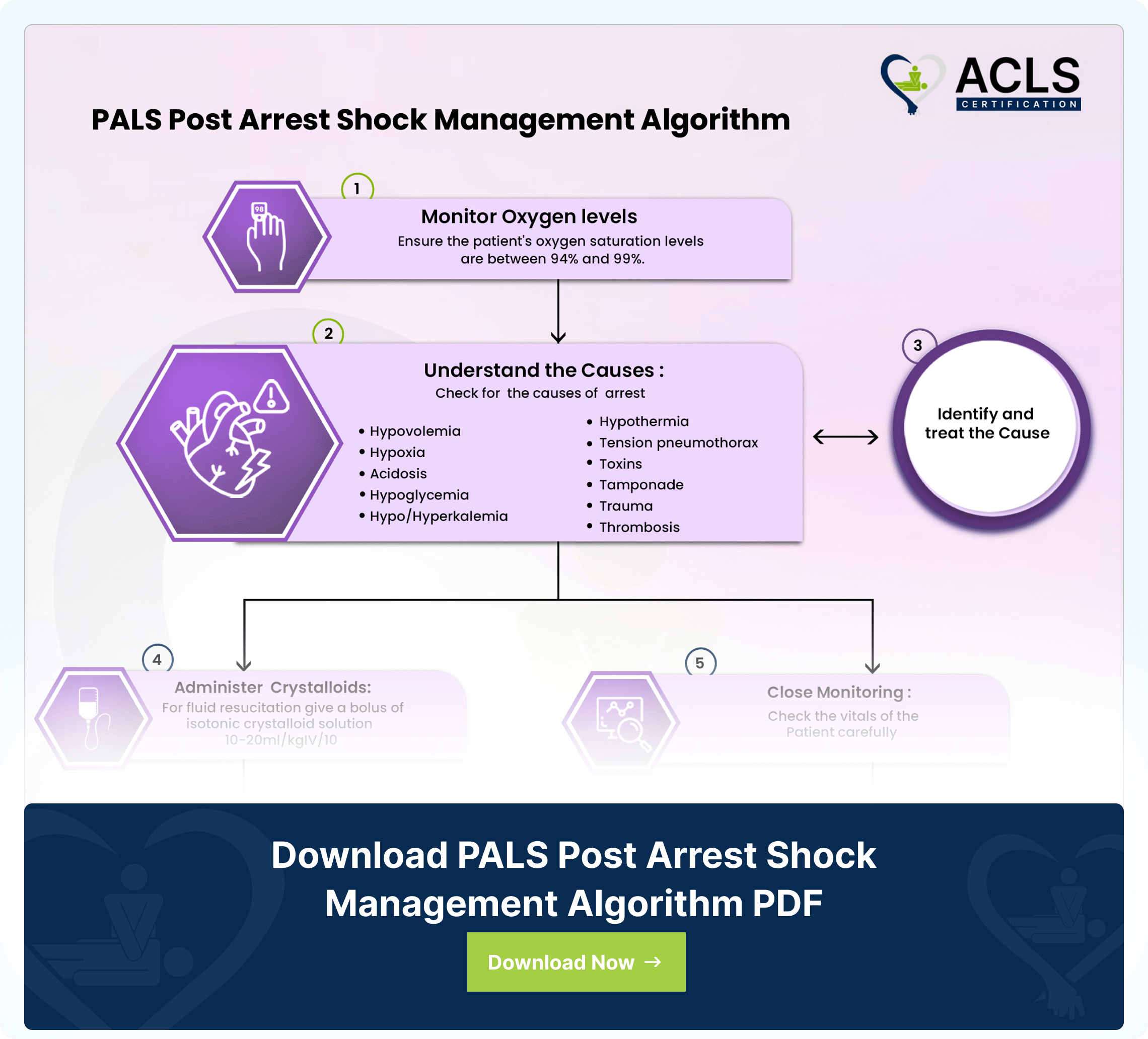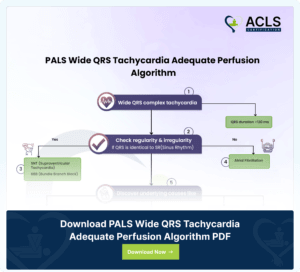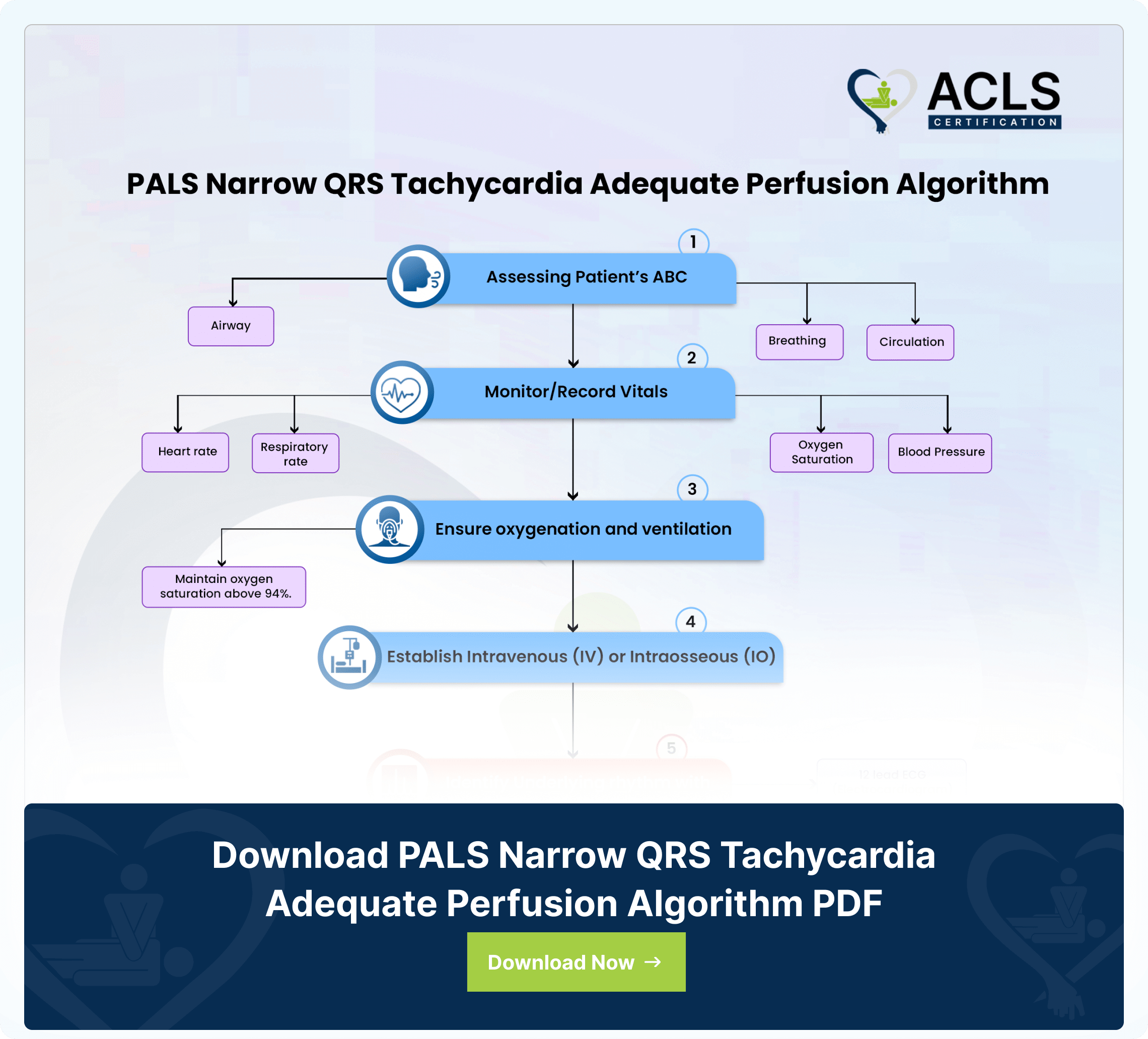The PALS (Pediatric Advanced Life Support) algorithm for managing narrow QRS Tachycardia with acute perfusion is a critical part of emergency care in the pediatric healthcare setting. The algorithm enables primary responders to take a structured approach towards diagnosis and treatment. The flowchart bears the structured approach to precisely detect and treat QRS tachycardia in pediatric patients. By following the ABC’s of resuscitation pediatric patients with narrow QRS Tachycardia can get the ideal supportive care.
Step by step analysis of flowchart
- Assessing Patient’s ABC
- Airway
- Breathing
- Circulation
- Monitor/Record Vitals
- Heart rate
- Respiratory rate
- Blood Pressure
- Oxygen Saturation
- Ensure oxygenation and ventilation
- Maintain oxygen saturation above 94%.
- Establish Intravenous (IV) or Intraosseous (IO).
- Identify Underlying rhythm with-
- 12 lead ECG (Electrocardiogram)
- Look Out for
- Hemodynamic Instability
- Altered mental status
- Poor perfusion
- Hypotension
- Signs of shock.
- Consider Vagal Maneuvers
- Carotid Massage
- Valsalva Maneuver
- Adenosine-
- For patients with stable narrow QRS tachycardia with Supraventricular Tachycardia (SVT).
- Initial dose: 1 mg/kg rapid IV push followed by a saline flush.
- Maximum initial dose: 6mg
- Consider Amiodarone or Procainamide
- Definitive Treatment-
- Catheter ablation
- Antiarrhythmic medications
- Electrical cardioversion
Highlights of PALS Narrow QRS Tachycardia Adequate Perfusion Algorithm
- Assessment: Initial evaluation of the patient’s (ABC) airway, breathing, circulation, and vital signs.
- Identification: Recognition of narrow QRS tachycardia on electrocardiogram (ECG) with consideration of underlying supraventricular tachycardia (SVT).
- Vagal Maneuvers: Application of vagal maneuvers like carotid massage or the Valsalva maneuver as initial interventions for SVT if appropriate.
- Adenosine Administration: Use Adenosine for stable SVT.
- Monitoring: Monitor patient’s cardiac rhythm, vital signs, and response to interventions.
- Definitive Treatment: Consider catheter ablation, antiarrhythmic medications, or electrical cardioversion based on the underlying rhythm and patient’s stability.
- Continued Support: Provision of supportive care, oxygenation, and IV/IO access while reassessing and adjusting interventions as needed.
Download PALS Narrow QRS Tachycardia Adequate Perfusion Algorithm PDF
Resources
- Wide QRS complex Tachycardia https://www.ncbi.nlm.nih.gov/books/NBK559054/
- Rapid heartbeat with stable QRS complexes https://www.healio.com/cardiology/learn-the-heart/ecg-review/ecg-topic-reviews-and-criteria/ventricular-tachycardia-review
- Assessment of vital signs to determine adequate perfusion https://www.ncbi.nlm.nih.gov/books/NBK553213/#:~:text=A%20low%20volume%20pulse%20could,generally%20more%20than%2080%20mmHg
- QRS tachycardia on electrocardiogram (ECG) https://www.uptodate.com/contents/narrow-qrs-complex-tachycardias-clinical-manifestations-diagnosis-and-evaluation
- Supraventricular tachycardia (SVT) https://www.nhs.uk/conditions/supraventricular-tachycardia-svt/#:~:text=Supraventricular%20tachycardia%20(SVT)%20is%20a,some%20people%20may%20need%20treatment
- Use of adenosine as a diagnostic and potentially therapeutic agent https://www.ncbi.nlm.nih.gov/books/NBK519049/
- Safety and Efficacy of Intravenous Procainamide and Amiodarone in the Acute Treatment of Wide QRS Complex Monomorphic Tachycardias https://www.acc.org/latest-in-cardiology/clinical-trials/2016/07/21/15/23/procamio#:~:text=Interpretation%3A,patients%20with%20structural%20heart%20disease
- Supportive Care Post QRS Tachycardia https://my.clevelandclinic.org/health/diseases/17616-ventricular-tachycardia
All PALS Algorithms

PALS Bradycardia Algorithm
The Pediatric Advanced Life Support (PALS) Bradycardia Algorithm gives a systematic approach to managing slow heart rates

PALS Post Arrest Shock Management Algorithm
The PALS Algorithm Stabilizes pediatric patients’ post-cardiac arrest optimizing recovery through targeted interventions

PALS Wide QRS Tachycardia Adequate Perfusion Algorithm
PALS Wide QRS Tachycardia Algorithm addresses critical pediatric cardiac conditions in an extremely systematic way. The flowchart helps medical professionals manage emergencies to ensure adequate perfusion in patients.



